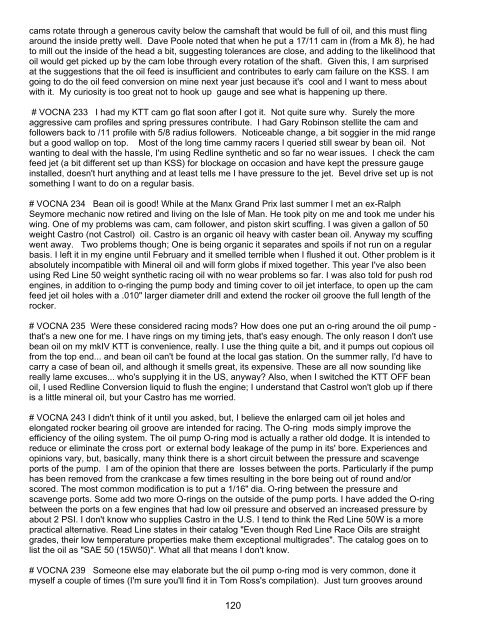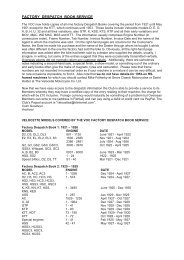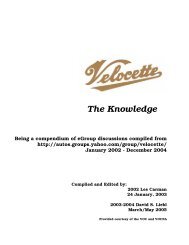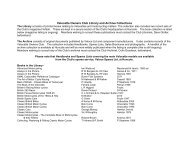The Knowledge - Velocette Owners Club
The Knowledge - Velocette Owners Club
The Knowledge - Velocette Owners Club
You also want an ePaper? Increase the reach of your titles
YUMPU automatically turns print PDFs into web optimized ePapers that Google loves.
cams rotate through a generous cavity below the camshaft that would be full of oil, and this must fling<br />
around the inside pretty well. Dave Poole noted that when he put a 17/11 cam in (from a Mk 8), he had<br />
to mill out the inside of the head a bit, suggesting tolerances are close, and adding to the likelihood that<br />
oil would get picked up by the cam lobe through every rotation of the shaft. Given this, I am surprised<br />
at the suggestions that the oil feed is insufficient and contributes to early cam failure on the KSS. I am<br />
going to do the oil feed conversion on mine next year just because it's cool and I want to mess about<br />
with it. My curiosity is too great not to hook up gauge and see what is happening up there.<br />
# VOCNA 233 I had my KTT cam go flat soon after I got it. Not quite sure why. Surely the more<br />
aggressive cam profiles and spring pressures contribute. I had Gary Robinson stellite the cam and<br />
followers back to /11 profile with 5/8 radius followers. Noticeable change, a bit soggier in the mid range<br />
but a good wallop on top. Most of the long time cammy racers I queried still swear by bean oil. Not<br />
wanting to deal with the hassle, I'm using Redline synthetic and so far no wear issues. I check the cam<br />
feed jet (a bit different set up than KSS) for blockage on occasion and have kept the pressure gauge<br />
installed, doesn't hurt anything and at least tells me I have pressure to the jet. Bevel drive set up is not<br />
something I want to do on a regular basis.<br />
# VOCNA 234 Bean oil is good! While at the Manx Grand Prix last summer I met an ex-Ralph<br />
Seymore mechanic now retired and living on the Isle of Man. He took pity on me and took me under his<br />
wing. One of my problems was cam, cam follower, and piston skirt scuffing. I was given a gallon of 50<br />
weight Castro (not Castrol) oil. Castro is an organic oil heavy with caster bean oil. Anyway my scuffing<br />
went away. Two problems though; One is being organic it separates and spoils if not run on a regular<br />
basis. I left it in my engine until February and it smelled terrible when I flushed it out. Other problem is it<br />
absolutely incompatible with Mineral oil and will form globs if mixed together. This year I've also been<br />
using Red Line 50 weight synthetic racing oil with no wear problems so far. I was also told for push rod<br />
engines, in addition to o-ringing the pump body and timing cover to oil jet interface, to open up the cam<br />
feed jet oil holes with a .010" larger diameter drill and extend the rocker oil groove the full length of the<br />
rocker.<br />
# VOCNA 235 Were these considered racing mods? How does one put an o-ring around the oil pump -<br />
that's a new one for me. I have rings on my timing jets, that's easy enough. <strong>The</strong> only reason I don't use<br />
bean oil on my mkIV KTT is convenience, really. I use the thing quite a bit, and it pumps out copious oil<br />
from the top end... and bean oil can't be found at the local gas station. On the summer rally, I'd have to<br />
carry a case of bean oil, and although it smells great, its expensive. <strong>The</strong>se are all now sounding like<br />
really lame excuses... who's supplying it in the US, anyway? Also, when I switched the KTT OFF bean<br />
oil, I used Redline Conversion liquid to flush the engine; I understand that Castrol won't glob up if there<br />
is a little mineral oil, but your Castro has me worried.<br />
# VOCNA 243 I didn't think of it until you asked, but, I believe the enlarged cam oil jet holes and<br />
elongated rocker bearing oil groove are intended for racing. <strong>The</strong> O-ring mods simply improve the<br />
efficiency of the oiling system. <strong>The</strong> oil pump O-ring mod is actually a rather old dodge. It is intended to<br />
reduce or eliminate the cross port or external body leakage of the pump in its' bore. Experiences and<br />
opinions vary, but, basically, many think there is a short circuit between the pressure and scavenge<br />
ports of the pump. I am of the opinion that there are losses between the ports. Particularly if the pump<br />
has been removed from the crankcase a few times resulting in the bore being out of round and/or<br />
scored. <strong>The</strong> most common modification is to put a 1/16" dia. O-ring between the pressure and<br />
scavenge ports. Some add two more O-rings on the outside of the pump ports. I have added the O-ring<br />
between the ports on a few engines that had low oil pressure and observed an increased pressure by<br />
about 2 PSI. I don't know who supplies Castro in the U.S. I tend to think the Red Line 50W is a more<br />
practical alternative. Read Line states in their catalog "Even though Red Line Race Oils are straight<br />
grades, their low temperature properties make them exceptional multigrades". <strong>The</strong> catalog goes on to<br />
list the oil as "SAE 50 (15W50)". What all that means I don't know.<br />
# VOCNA 239 Someone else may elaborate but the oil pump o-ring mod is very common, done it<br />
myself a couple of times (I'm sure you'll find it in Tom Ross's compilation). Just turn grooves around<br />
120





